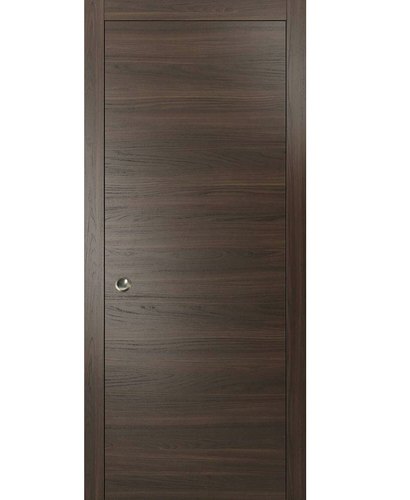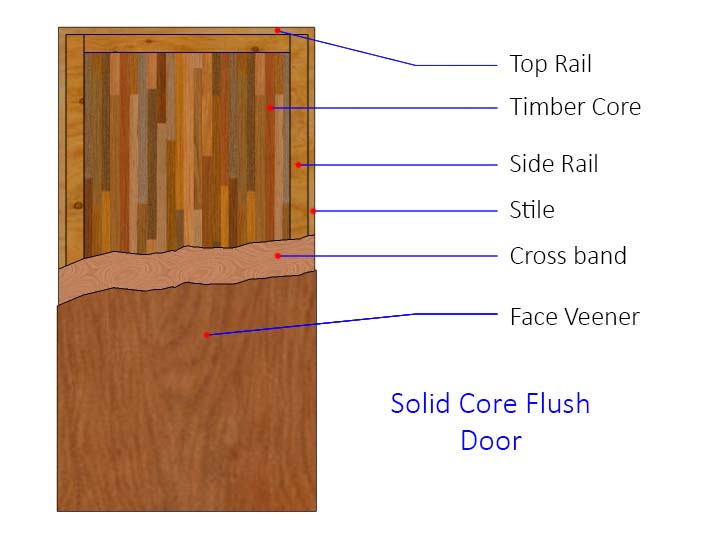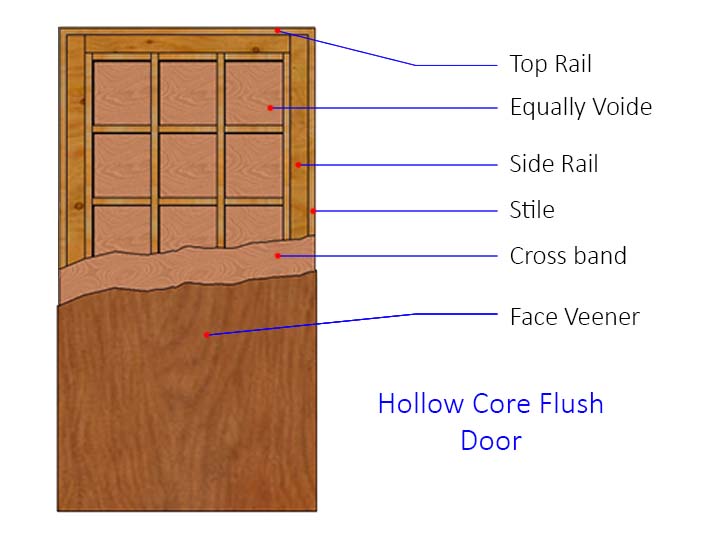Flush doors are becoming more and more popular these days due to their pleasing appearance, simplicity of construction, lower cost, better strength, and increased durability. They are used for both residential as well as commercial and public buildings. These doors consist of a solid or semi-solid skeleton or core covered on both sides with plywood, face veneers, etc. They have a smooth, seamless surface that can be polished to perfection.

What is a Flush Door?
A flush door is a type of door that is characterized by its smooth and flat surface, lacking any raised or recessed panels. The term “flush” refers to the fact that the door is constructed with a flat, even surface on both sides. These doors are often favoured for their contemporary and minimalist aesthetic, and they seamlessly blend into modern interior design.
Anatomy of Wood Flush Door
The anatomy of a wood flush door consists of various components that work together to create a functional and aesthetically pleasing interior door.
- Veneer or Surface Material:
- The surface of wood flush doors is often covered with a veneer, which is a thin layer of real wood. Common wood veneers include oak, mahogany, walnut, and maple. Veneers provide the natural beauty of wood while maintaining a smooth and flat surface.
- Core Material:
- Solid Core: Some wood flush doors feature a solid core, which is made of dense material such as particleboard or MDF (Medium Density Fiberboard). This provides the door with strength, durability, and sound insulation properties.
- Hollow Core: Other flush doors have a hollow core, typically filled with honeycomb-like cardboard or other lightweight material. Hollow core doors are lighter and more affordable but may offer less sound insulation.
- Lipping:
- Lipping refers to the thin strips of wood that are applied to the edges of the door. These strips serve to cover the core material and provide a finished appearance to the sides of the door.
- Stiles and Rails:
- Stiles are the vertical components of the door frame, while rails are the horizontal components. In a wood flush door, stiles and rails are often made from solid wood and contribute to the structural integrity of the door. These components frame the door and help maintain its overall shape.
Types of Flush Doors
Flush doors come in various types, each designed to meet specific functional and aesthetic requirements. Here are some common types of flush doors according to the filled or hollow core:
- Solid core flush door
- Laminated core flush door
- Hollow Core Door
- Cellular Core Flush Door
Solid Core Flush Door
The solid core flush door consists of a wooden frame. The top and bottom rails are used to hold the core. The core consists of strips of wood glued together under great pressure and clad on each side with sheets of plywood, or block board, particle board or a combination of particle board and block board, faced with plywood sheet.

Laminated Core flush door
In the laminated core flush door, the wooden strips have a maximum width of 25 mm glued together and the length of each strip is equal to the length of the laminated core. In each type of core, plywood sheets are glued under pressure to the assembly of the core housed in the frame on both faces.
Alternatively, separate crossbands and cladding faces (veneer) can be glued on both sides, with the crossband fibres at right angles to the core and the veneer grain at right angles to the crossband. The core is housed in the outer façade (stiles) with uprights, and top and bottom rails, each not less than 75mm wide. Such doors are quite strong, but they are heavy and require more materials.

Hollow Core Flush Door
A hollow core flush door consists of a frame made up of styles, top rail, bottom rail, and a minimum of two mid rails. The width of the intermediate rails is usually 75 mm thick. The interior space of the frame is provided with equally spaced batten, each with a minimum width of 25 mm so that the empty area is limited to 500 cm2.

Also, read: Advantages And Disadvantages Of Flush Doors
Cellular Core Flush Door
A cellular core flush door consists of a style frame, a top rail and a bottom rail, each with a minimum width of 75mm. The empty space is filled with equidistant strips of wood or plywood, each with a minimum width of 25 mm. The battens are arranged so that the void space between adjacent vertical and horizontal battens does not exceed 25 cm2 in area, and the total void area does not exceed 40% of the shutter area.
In the Hollow core and Cellular core flush doors, the shutter is formed by glueing plywood sheets or cross-band and face veneers on both faces under pressure. The materials for the flush door are specified in IS 2191: 1983 (part-1).

Also, read: Types Of Door Frames: Size, Materials & Specification
Depending Upon the Materials Used for Flush Doors
Traditionally flush doors are made of wood components. With the rapid development in materials and the demand from the construction industries, many materials have been immersed for the use of making flush doors.
- FRP (Fibre-reinforced plastic) flush door
- PVC flush door
- WPC (wood plastic composite) flush door
- Laminated flush door
- Aluminium flush door
Comparisons Between Flush Doors and Wooden Doors
| Flush Door | Wooden Door |
|---|---|
| Usually made from softwood skeleton and cladding with plywood on both sides in the case of hollow core flush doors. Solid core and laminated doors are filled with hardwood and covered with veneer. | Are made of any kind of wood. Blue pine, conifer, and teak are some of the common types of timber used for doors. |
| They are plain finished with little grooving on the surface. | Wooden doors are designed for panel or glaze and single leaf. |
| Alteration in the door is not permissible. | Alterations in terms of design and size are easily applicable. |
Also, read: Types Of Doors Used In Building Construction: 11 Types
FAQs:
Q: What is the flush door?
Ans: A flush door is a type of door that has a perfectly smooth surface and is made by cladding of plywood over a light wood frame. The flush door is one of the most widely used doors in residential buildings that comes with an attractive design and rich appearance.
Q: What are the types of flush doors?
Ans: Flush doors are of the following types: –
1. Solid core flush door
2. Laminated core flush door
3. Hollow Core Door
4. Cellular Core Flush Door
Q: What is the major category of flush doors?
Ans: The major categories of flush doors are solid core flush doors and Hollow core flush doors.
![]()







